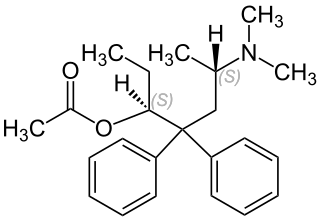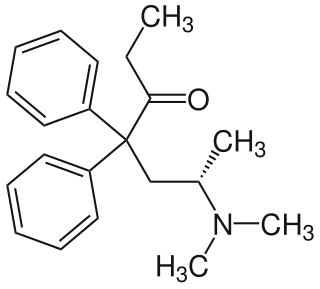
Methadone, sold under the brand names Dolophine and Methadose among others, is a synthetic opioid agonist used for chronic pain and also for opioid dependence. It is used to treat chronic pain, and it is also used to treat addiction to heroin or other opioids. Prescribed for daily use, the medicine relieves cravings and removes withdrawal symptoms. Detoxification using methadone can be accomplished in less than a month, or it may be done gradually over as long as six months. While a single dose has a rapid effect, maximum effect can take up to five days of use. The pain-relieving effects last about six hours after a single dose. After long-term use, in people with normal liver function, effects last 8 to 36 hours. Methadone is usually taken by mouth and rarely by injection into a muscle or vein.

Opioid use disorder (OUD) is a substance use disorder relating to the use of an opioid. Any such disorder causes significant impairment or distress. Signs of the disorder include a strong desire to use opioids, increased tolerance to opioids, difficulty fulfilling obligations, trouble reducing use, and withdrawal symptoms with discontinuation. Opioid withdrawal symptoms may include nausea, muscle aches, diarrhea, trouble sleeping, agitation, and a low mood. Addiction and dependence are components of a substance use disorder. Complications may include opioid overdose, suicide, HIV/AIDS, hepatitis C, and problems at school, work, or home.

Buprenorphine is an opioid used to treat opioid use disorder, acute pain, and chronic pain. It can be used under the tongue (sublingual), in the cheek (buccal), by injection, as a skin patch (transdermal), or as an implant. For opioid use disorder, it is typically started when withdrawal symptoms have begun and for the first two days of treatment under direct observation of a health-care provider. In the United States, the combination formulation of buprenorphine/naloxone (Suboxone) is usually prescribed to discourage misuse by injection. Maximum pain relief is generally within an hour with effects up to 24 hours. Buprenorphine affects different types of opioid receptors in different ways. Depending on the type of receptor, it may be an agonist, partial agonist, or antagonist. In the treatment of opioid use disorder buprenorphine is an agonist/antagonist, meaning that it relieves withdrawal symptoms from other opioids and induces some euphoria, but also blocks the ability for many other opioids, including heroin, to cause an effect. Unlike full agonists like heroin or methadone, buprenorphine has a ceiling effect, such that taking more medicine will not increase the effects of the drug.
A methadone clinic, or substance use disorder services clinic (SUDS), is a clinic which has been established for the dispensing of medications used in the treatment of opiate dependence —historically and most commonly methadone, although buprenorphine is also increasingly prescribed. Medically assisted drug therapy treatment is indicated in patients who are opioid-dependent or have a history of opioid dependence. Methadone is a schedule II (USA) opioid analgesic, that is also prescribed for pain management. It is a long-acting opioid that can delay the opioid withdrawal symptoms that patients experience from taking short-acting opioids, like heroin, and allow time for detoxification. In the United States, by law, patients must receive methadone under the supervision of a physician, and dispensed through an opioid treatment program certified by Substance Abuse and Mental Health Services Administration and registered with the Drug Enforcement Administration.

Dipipanone (Pipadone) is a strong opioid analgesic drug, used for acute pain by mouth (PO) for adults - initially 10 mg every 6 hours, then increased if necessary up to 30 mg every 6 hours, with the dose to be increased gradually. It is often used in instances where morphine is indicated but cannot be used due to the patient being allergic to morphine. In analgesic potency 25 mg dipipanone is approximately equivalent to 10 mg morphine.

The Methadones were a band formed in 1993 by guitarist/vocalist Dan Vapid. The Methadones initially lasted only a few shows before Dan put them to the side to focus on his main band Screeching Weasel. By 1999 Dan was no longer a member of Screeching Weasel or his other band The Riverdales, and decided to restart The Methadones with B-Face of The Queers on bass, and Dan Lumley on drums. The band recorded their first album Ill at Ease in 2001. After the recording, B-Face and Lumley left the band. Schafer formed a new lineup of The Methadones with guitarist Mike Byrne, bassist Sensitive Pete, and drummer Mike Soucy.

Dan Schafer, better known by his stage name Dan Vapid, is a punk rock musician from Chicago, Illinois, United States. He is best known for his participation in Screeching Weasel, The Riverdales, The Methadones, and various other punk rock/pop punk bands. His current band is Dan Vapid and the Cheats.
Daniel Wayne Smith was the son of the American model and actress Anna Nicole and Billy Smith. He occasionally appeared in his mother's E! Network reality TV show. Smith died on September 10, 2006, at age 20, after an accidental overdose.

Phenadoxone is an opioid analgesic of the open chain class invented in Germany by Hoechst in 1947. It is one of a handful of useful synthetic analgesics which were used in the United States for various lengths of time in the 20 or so years after the end of the Second World War but which were withdrawn from the market for various or no known reason and which now are mostly in Schedule I of the United States' Controlled Substances Act of 1970, or in Schedule II but not produced or marketed in the US. Others on this list are ketobemidone (Ketogin), dextromoramide, phenazocine, dipipanone, piminodine (Alvodine), propiram (Algeril), anileridine (Leritine) and alphaprodine (Nisentil).

Levacetylmethadol (INN), levomethadyl acetate (USAN), OrLAAM or levo-α-acetylmethadol (LAAM) is a synthetic opioid similar in structure to methadone. It has a long duration of action due to its active metabolites.

Prodine is an opioid analgesic that is an analog of pethidine (meperidine). It was developed in Germany in the late 1940s.

An opiate, in classical pharmacology, is a substance derived from opium. In more modern usage, the term opioid is used to designate all substances, both natural and synthetic, that bind to opioid receptors in the brain. Opiates are alkaloid compounds naturally found in the opium poppy plant Papaver somniferum. The psychoactive compounds found in the opium plant include morphine, codeine, and thebaine. Opiates have long been used for a variety of medical conditions with evidence of opiate trade and use for pain relief as early as the eighth century AD. Opiates are considered drugs with moderate to high abuse potential and are listed on various "Substance-Control Schedules" under the Uniform Controlled Substances Act of the United States of America.
Marie Nyswander was an American psychiatrist and psychoanalyst known for developing and popularizing the use of methadone to treat heroin addiction.

Isomethadone is a synthetic opioid analgesic and antitussive related to methadone that was used formerly as a pharmaceutical drug but is now no longer marketed. Isomethadone was used as both an analgesic and antitussive. It binds to and activates both the μ- and δ-opioid receptors, with the (S)-isomer being the more potent of its two enantiomers. Isomethadone is a Schedule II controlled substance in the United States, with an ACSCN of 9226 and a 2014 aggregate manufacturing quota of 5 g. The salts in use are the hydrobromide, hydrochloride, and HCl monohydrate (0.850). Isomethadone is also regulated internationally as a Schedule I controlled substance under the United Nations Single Convention on Narcotic Drugs of 1961.

Levomethadone, sold under the brand name L-Polamidon among others, is a synthetic opioid analgesic and antitussive which is marketed in Europe and is used for pain management and in opioid maintenance therapy. In addition to being used as a pharmaceutical drug itself, levomethadone is the main therapeutic component of methadone.
Methadone maintenance treatment is the use of the medicine methadone, administered on an ongoing basis, as treatment for dependence on heroin or other opioids. Methadone is an opioid agonist, binding to the same receptor in the brain as heroin or other opioids, and relieving withdrawal symptoms and causing respiratory depression and euphoria in some or at higher doses. Know to be one of the best researched of medically assisted approaches to addiction treatment. Methadone maintenance reduces craving for or use of other opioids, and reduces risk of fatal overdose from street drugs. Involving a daily dose of prescribed medicine, methadone maintenance has been termed "a first step toward social rehabilitation" because it increases retention of patients in treatment, relieves them from the need to find, buy and use multiple daily doses of street opioids, and offers a legal medical alternative.

Esmethadone, also known as dextromethadone, is the (S)-enantiomer of methadone. It acts as an N-methyl-D-aspartate receptor (NMDAR) antagonist. Unlike levomethadone, it has low affinity for opioid receptors and lacks significant respiratory depressant action and abuse liability. Esmethadone is under development for the treatment of major depressive disorder. There is an asymmetric synthesis available to prepare both esmethadone and levomethadone.

The Taiwan Centers for Disease Control is the agency of the Ministry of Health and Welfare of Republic of China (Taiwan) that combats the threat of communicable diseases.

Buprenorphine/naloxone, sold under the brand name Suboxone among others, is a fixed-dose combination medication that includes buprenorphine and naloxone. It is used to treat opioid use disorder, and reduces the mortality of opioid use disorder by 50%. It relieves cravings to use and withdrawal symptoms. Buprenorphine/naloxone is available for use in two different forms, under the tongue or in the cheek.
The Al-Rahman Mosque is a mosque in Kuala Lumpur, Malaysia. The mosque is located at University of Malaya in Jalan Pantai Baharu and was named after the first Malaysian Prime Minister, Tunku Abdul Rahman Putra Al-Haj. Today, the mosque is joint managed by University of Malaya and the Department of Federal Territory Islamic Affairs (JAWI).














